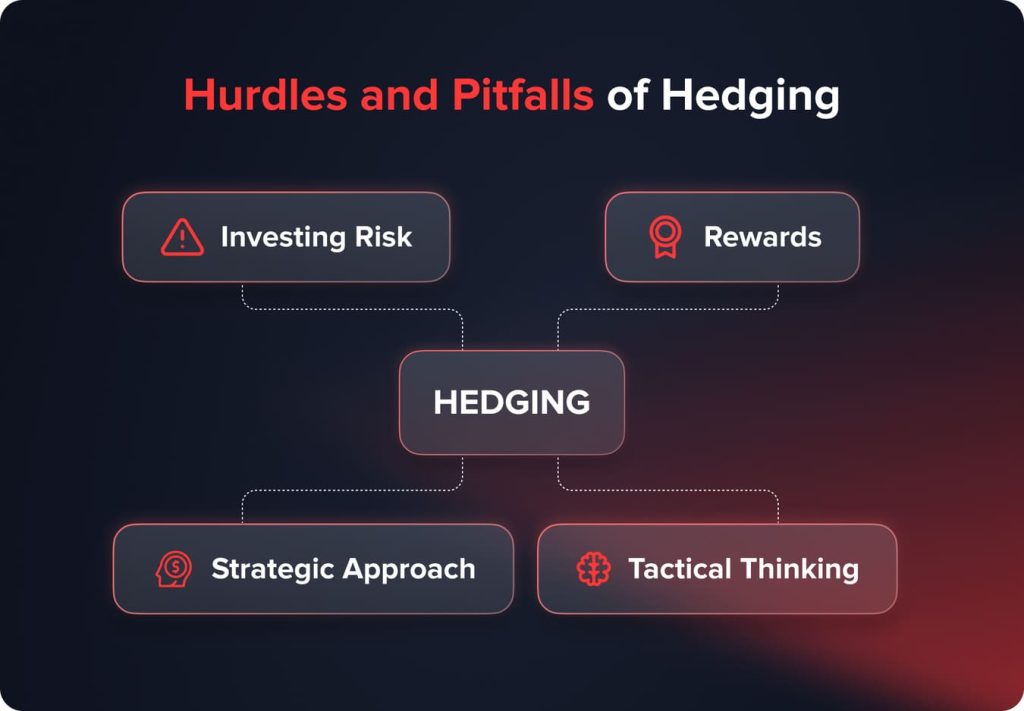
¿Qué es la cobertura? Mejores prácticas en 2024
Contenidos
En el mundo financiero, las inversiones siempre conllevan riesgos, independientemente de la agresividad de la estrategia elegida. Los inversores profesionales se adhieren a diversas pólizas de seguro que compensan posibles pérdidas. La cobertura de riesgos se enmarca en este tipo de pólizas.
¿Qué es la cobertura en finanzas?
La mejor manera de entender qué significa la cobertura es establecer un paralelo con el seguro. Cuando una persona desea proteger su propiedad de causas de fuerza mayor, firma un contrato con una compañía de seguros. Por un lado, se enfrentan a gastos adicionales. Por otro lado, el seguro cubre todas las pérdidas en caso de fuerza mayor. De esta forma, se minimizan los posibles riesgos.
En el mercado financiero, todo es más complicado. No se puede simplemente llegar a un acuerdo con una compañía de seguros para cubrir pérdidas.
La cobertura ayuda a los inversores a equilibrar sus posiciones abriendo una orden en la dirección opuesta. Esta opción permite equilibrar las fluctuaciones de precios. La cobertura es lo suficientemente eficaz como para proteger diferentes activos:
- monedas;
- cepo;
- mercancías;
- metales, etc.
¿Cómo funciona la cobertura?
El uso de un instrumento para minimizar los posibles riesgos La conexión con otro instrumento se basa en la cobertura. En la mayoría de los casos, los operadores e inversores reducen los riesgos mediante derivados. Veamos algunos ejemplos de cómo funciona la cobertura.

Un productor de gasolina compra petróleo con la intención de producir gasolina en un plazo de tres meses y luego venderla. Mientras tanto, durante los tres meses siguientes, los precios del petróleo podrían caer y causar pérdidas; por ello, el productor suscribe un contrato a plazo para el suministro de gasolina con vencimiento a tres meses. Por otro lado, un productor puede abrir una opción de venta para minimizar los riesgos asociados a la posible caída del precio y obtener beneficios adicionales cuando los precios del petróleo suban.
Una empresa japonesa suministra bienes a Estados Unidos y recibe pagos en dólares estadounidenses. Los dólares se convierten posteriormente a yenes japoneses (JPY). Para cubrir los riesgos de la subida del tipo de cambio JPY/USD, la empresa compra futuros de JPY/USD.
Texas recibe el 25% de los impuestos locales de las empresas productoras y refinadoras de petróleo. Cuando bajan los precios mundiales del petróleo, el estado recibe menos impuestos. El programa de cobertura implementado en Texas ayudó al estado a estabilizar los flujos de efectivo en diferentes condiciones de mercado.
You may also like

Principios básicos de la cobertura
Este enfoque para minimizar los riesgos se basa en los principios siguientes:
- Un programa de cobertura eficaz no pretende excluir los riesgos en absoluto. El objetivo principal reside en transformar los riesgos de inaceptables a aceptables.
- Al considerar la cobertura, una empresa o un inversor debe evaluar las posibles pérdidas que podrían ocurrir sin ella. Cuando estas pérdidas son insignificantes, los beneficios de implementarla son cuestionables.
- Como cualquier otra actividad financiera, un programa de cobertura requiere un sistema de reglas y etapas internas estrictas.
Por lo tanto, la cobertura no es la salvación del inversor en todas las situaciones del mercado. Es necesario comprender qué riesgos deben minimizarse y cuáles deben asumirse.
Instrumentos de cobertura
Ante todo, al hablar de cobertura, considere el objetivo, no los medios. Tanto los que cubren como los operadores utilizan los mismos instrumentos. Los primeros aplican instrumentos para reducir los riesgos ante posibles fluctuaciones de precios. Los operadores asumen esos riesgos apostando conscientemente por resultados beneficiosos.
Todos los instrumentos de cobertura se dividen en dos grupos: de cambio y Instrumentos OTC.
Instrumentos de cobertura negociados en bolsa
La categoría de instrumentos de cobertura negociados en bolsa está representada principalmente por futuros y opciones. Estos instrumentos están disponibles en las bolsas; por ello, la Cámara de Compensación de Bolsas garantiza que tanto compradores como vendedores cumplan con sus obligaciones.
Las ventajas de los instrumentos de cobertura negociados en bolsa:
- Estos instrumentos se caracterizan por la máxima liquidez y los inversores pueden comprar y vender activos a precio de mercado en los plazos más cortos.
- Las transacciones están protegidas por la Cámara de Compensación del Mercado de Valores.
- Gracias a las tecnologías actualizadas, los comerciantes e inversores acceden a las plataformas comerciales desde cualquier parte del mundo.
Las desventajas de los instrumentos de cobertura negociados en bolsa:
- Los cambios implican restricciones relacionadas con el tamaño de los lotes, las condiciones y el tiempo de entrega.
- Los compradores y vendedores pagan comisiones y tarifas de cambio.
Instrumentos de cobertura OTC (Over the Counter)
Instrumentos OTC Los contratos de cobertura utilizados son principalmente contratos a plazo y swaps. Ambas partes realizan estas operaciones directamente o a través de intermediarios.
Las ventajas de los instrumentos de cobertura OTC:
- Los inversores obtienen instrumentos que tienen en cuenta el tipo de producto, los volúmenes y las condiciones de entrega.
- Las comisiones y tarifas no existen o son mínimas ya que las dos partes deciden directamente todas las condiciones.
Las desventajas de los instrumentos de cobertura negociados en bolsa:
- Los costos generales son bastante altos.
- Los inversores se enfrentan a restricciones importantes relacionadas con el tamaño mínimo del lote.
- A veces es difícil encontrar una contraparte.
Por lo tanto, todos los instrumentos de cobertura tienen sus ventajas y desventajas. Los inversores deben encontrar la mejor opción según las condiciones particulares.
Estrategias de cobertura
El término "estrategia de cobertura" se refiere comúnmente a un conjunto de herramientas y métodos. Todas las estrategias se basan en la fluctuación paralela de los precios al contado y de futuros. Los inversores tienen la oportunidad de utilizar derivados como mecanismos de seguro.
Profundicemos en las principales estrategias de cobertura.
Cobertura mediante contratos de futuros
La estrategia requiere la venta de contratos de futuros. El volumen de estos contratos debe corresponder al lote cubierto de activos reales.
¿Qué hay que tener en cuenta?
- Los inversores que venden contratos de futuros pueden evaluar el coste principal de los activos con gran certeza.
- Los precios en el mercado de derivados proporcionan a los inversores unos beneficios aceptables.
La cobertura mediante contratos de futuros fija el precio de los activos que se ofrecerán en el futuro. Si el precio de un activo en el mercado al contado baja, el inversor recibe una compensación de los instrumentos derivados. Por otro lado, si el precio sube en el mercado al contado, los inversores no obtienen beneficios adicionales, ya que deben cubrir las pérdidas derivadas de los contratos de futuros.
Cobertura mediante opciones de venta
La opción de venta permite a su titular vender el activo subyacente a un precio fijo (el precio de ejercicio de la opción) dentro del plazo de vencimiento. Por otro lado, el titular de dicha opción no está obligado a ejercer su derecho. Él decide si vende o no el activo subyacente.
Al comprar una opción de venta, los inversores fijan el precio mínimo de venta. Cuando el precio de un activo sube en el mercado al contado, los inversores simplemente pagan recompensas, renunciando a su derecho a venderlo. En caso de una caída del precio, los inversores activan su derecho a vender un activo a un precio fijo superior al del mercado al contado.
Cobertura mediante opciones de compra
La estrategia funciona de la misma manera que la anterior pero en lugar de opciones de venta los inversores compran opciones de compra que dan derecho a comprar el activo subyacente a un precio fijo.
Cuando el precio de un activo sube, los tenedores ejercen su derecho a comprarlo. Si el precio baja, los inversores pagan recompensas y renuncian a su derecho a comprarlo.
Otros instrumentos de cobertura
Existen muchas otras herramientas de cobertura basadas en opciones de compra y venta. Por ejemplo, se venden opciones de compra y se compran opciones de venta con recompensas. La selección de los instrumentos de cobertura depende de un análisis detallado de las necesidades comerciales del coberturista, la situación económica general y las oportunidades futuras del sector.
Obstáculos y trampas de la cobertura
La cobertura no ayuda a los inversores a compensar los riesgos en cualquier situación de mercado. Este enfoque presenta algunos obstáculos y dificultades:

- La cobertura de posiciones a largo plazo es más compleja, ya que los inversores no pueden encontrar instrumentos derivados a largo plazo con suficiente liquidez. En este caso, se utiliza la estrategia de renovación. Primero, los inversores compran opciones con vencimientos más cortos. A medida que se acerca el vencimiento, venden una opción y compran otra con vencimiento más largo.
- En ocasiones, los inversores no pueden seleccionar una materia prima cotizada en bolsa que se corresponda plenamente con un activo real utilizado en transacciones al contado. En tales casos, deben realizar un análisis exhaustivo para determinar qué activos se asemejan lo más posible a los reales.
- Una variación de precio puede afectar el volumen de ventas y dar lugar a que una posición cubierta sea menor o mayor que una al contado. En ambas situaciones, los inversores se enfrentan a mayores riesgos. La mejor solución reside en la cobertura dinámica (por ejemplo, la cobertura delta).
¿Qué es Delta Hedging y cómo funciona?
La cobertura delta es una estrategia que ayuda a los inversores a gestionar el riesgo de variación del precio de una opción en respuesta a la variación del precio de un activo subyacente. El delta muestra cuánto cambiará el precio de una opción cuando el precio de un activo subyacente suba o baje. Por lo tanto, la cobertura delta consiste en la variación constante del volumen de opciones para mantener un coeficiente delta determinado.
Por ejemplo, un coeficiente delta es igual a cero cuando el activo subyacente se mantiene al mismo nivel de precio. Cuando su precio sube o baja, el coeficiente también experimenta cambios. Para mantener el equilibrio, un inversor necesita reajustar su posición. Cuando el precio de un activo subyacente sube, los inversores compran más lotes. En caso de una caída de precio, conviene vender algunos lotes.
Gastos relacionados con la cobertura
La principal diferencia entre la cobertura y otras estrategias de trading radica en que la cobertura busca minimizar los riesgos, no obtener beneficios adicionales; por lo tanto, implica gastos adicionales. ¿Cuáles son esos costos?
- Cuando un coberturista realiza una operación, transfiere parte del riesgo a la contraparte (otro coberturista o un operador). Las contrapartes asumen riesgos adicionales y esperan obtener recompensas. Por ejemplo, un coberturista paga por la compra de una opción, independientemente de si ejerce o no su derecho a comprar o vender activos.
- Todas las transacciones están sujetas al pago de tarifas e implican precios de oferta y demanda.
- Las plataformas de negociación cobran depósitos de garantía para garantizar el cumplimiento de las obligaciones de ambas partes. El depósito de garantía suele oscilar entre el 2 % y el 20 % del volumen total de la posición cubierta.
- Otro gasto que los coberturistas deben tener en cuenta es la financiación. Los titulares de posiciones de futuros pagan financiación cuando el precio se mueve en la dirección elegida. En caso de movimiento contrario, los coberturistas obtienen financiación sobre sus saldos.
Los gastos mencionados anteriormente pueden afectar sus posiciones cubiertas, por lo que es necesario tener en cuenta esas recompensas, tarifas y costos de financiación.
Riesgos relacionados con las estrategias de cobertura
La cobertura en sí misma es un instrumento que minimiza los riesgos; sin embargo, los enfoques existentes no pueden excluir la dependencia de fluctuaciones incorrectas de precios. Además, una estrategia de cobertura insuficientemente desarrollada puede incrementar los riesgos.
El principal tipo de riesgo que surge en la cobertura reside en las diferencias entre las fluctuaciones de precios de los activos reales y los correspondientes instrumentos derivados. Los precios de los activos reales y los derivados suelen fluctuar en paralelo y no pueden diferir esencialmente, pero siempre existe cierto riesgo básico.
Otro tipo de riesgo implica límites administrativos a las fluctuaciones diarias máximas de los precios de futuros. Estas restricciones las establecen algunas bolsas. Cuando un operador de cobertura necesita cerrar su posición durante fuertes fluctuaciones en el precio de un activo real, la diferencia entre los precios al contado y los de los derivados es bastante grande.
Otro tipo de riesgo está relacionado con cambios legislativos impredecibles, es decir, derechos, impuestos especiales, etc.
¿Qué obtienen los inversores de cobertura?
Al hablar de estrategias de cobertura, los inversores y las empresas experimentan los siguientes beneficios:
- La cobertura reduce significativamente los riesgos de precios asociados con la incertidumbre de los flujos financieros futuros, las tasas de interés y los tipos de cambio.
- Una estrategia de cobertura bien planificada reduce tanto los riesgos como los gastos. La cobertura ayuda a las empresas a centrarse en aspectos donde tienen ventajas competitivas.
En resumen: ¿Es la cobertura una herramienta imprescindible para las inversiones?
Al hablar de inversión y procesos de negocio, los inversores o las empresas pueden estar dispuestos a asumir un riesgo y protegerse de otros. En tal situación, la cobertura parece la herramienta perfecta.
La cobertura funciona como un programa de seguros en los mercados financieros. Sin embargo, la posición cubierta no significa que los inversores o las empresas no sufran pérdidas. Existen algunos gastos y riesgos relacionados con la cobertura, y una estrategia incorrecta puede generar riesgos aún mayores en lugar de minimizarlos.
Actualizado:
19 de diciembre de 2024



